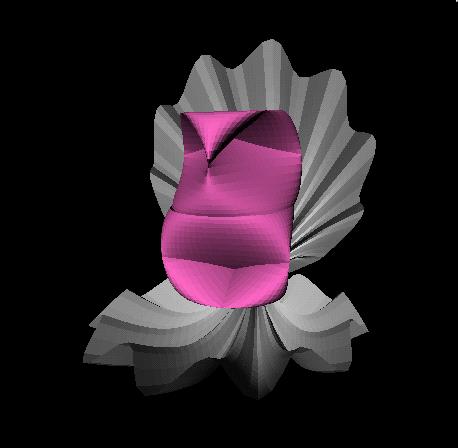 Image by Stewart Dickson © 1999
Image by Stewart Dickson © 1999
by
 Image by Stewart Dickson © 1999
Image by Stewart Dickson © 1999
This is a re-worked artifact of CyberSpace -- my own implementation in Mathematica of the George Francis/Donna Cox/Ray Idaszak "Etruscan Venus" being born in a scallop shell which I also created using Mathematica.
The "Etruscan Venus" is composed of two Steiner "Roman" or Quartic Surfaces put together. A "Roman" surface is a Moebius band with its one edge shrunk to a point. If you put two Moebius bands together at their seam (they normally have to be twisted in opposite directions to do this) you get a Klein bottle. The "Roman" surface has tetrahedral symmetry, so there's no "handedness", unlike the Moebius band.
In the Etruscan Venus, the two "Roman" surfaces are joined by opening each at a point at the 'bottom' of the parameterization.
Another funny thing about this is that there is another surface, topologically related to the Steiner "Roman" surface, called the Werner Boy surface. Francois Apery invented the mathematics to do the "homotopy" -- or 3-D morph -- from the "Roman" surface to the Boy surface. George Francis calls this the RomBoy Homotopy. Francis/Idaszak/Cox also morph the Venus between these two forms. I think they thought this form must be the "Girl" surface. Donna uses it as a female icon.
The half-Venus is a really feindish object, topologically. It took me from October, 1999 until February of 2004 to get a parameterisation that could be 'thickened' for Rapid Prototyping. The features in thicken dealing with SoQuadMeshes were written primarily to solve the problem of building the Etruscan Venus.
 Image by Joe Richey © 2004
Image by Joe Richey © 2004
The halves of "Botty Shelly" being constructed on a Stratasys Prodigy Fused Deposition Modeler by Tri-City Machine Products, Inc. under the name of the Prairie Center of the Arts at the Discovery Forum, Peoria, Illinois in February of 2004.

The two halves of "Botty Shelly" as constructed in FDM.

"Botty Shelly" -- the artist's proof -- in need of a little clean-up and mould-making for reproduction.

A two-piece silicone mold and reproductions of the FDM original in cast polyurethane.
 "Botty Shelly" (2005) height: 4.5", acrylic on polyurethane and seashell --
edition of 8.
"Botty Shelly" (2005) height: 4.5", acrylic on polyurethane and seashell --
edition of 8.
This is not an hommage in the manner of my previous mathematical concretizations.
This is a work of appropriated art and found mathematics. The only original contribution to this work is the programming which went into thickening the mesh for rapid prototyping -- which is nearly invisible -- and the juxtaposition of the Etruscan Venus with Botticelli's seashell.
In 1987, Donna Cox juxtaposed the Etruscan Venus with the Venus of Willendorf, a statement of timescale and a treatment of the feminine ideal which flies in the face of popular stereotypes of beauty.
This is a work of postmodern Dada. It is Marcel Duchamp's Female Figleaf presented upon a scallop shell. Circa 1978 there was a story about an IUD which was of the form of a Klein bottle. It functioned by sending the male emission through the fourth dimension. Donna Cox' "Venus and Milo" has the Venus ingesting chocolates and the vacuum cleaner recursively ingesting the Venus and the janitor. I choose to think of the Venus as the Hole which engulfs all.
If this work is an hommage at all, then it is Annie Sprinkle's Public Cervix as a four-dimensional object.
Art Historical Reference:
Femalic Molds by Jean Clair (translation by Taylor M. Stapleton) Excerpt from Marcel Duchamp et la fin de l'art, by Jean Clair (Paris: Gallimard, 2000).